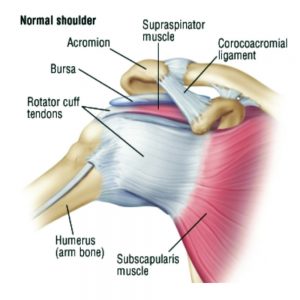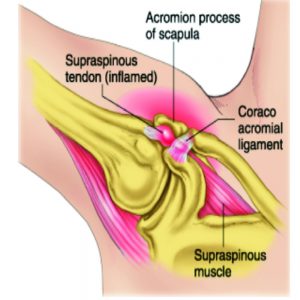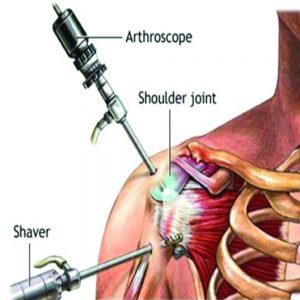Pain in the shoulder joint can come from many structures around the joint but the most common problem occur in a narrow space between the bone of the shoulder. Between this space lies the rotator cuff and it bursa. Rotator cuff is made up of 4 groups of tendons, Supraspinatus, Infraspinatus, Teres minor and Subscapularis. These tendons connect the muscles from the shoulder blade to the upper arm. This tendons form a cuff around the shoulder joint that stabilise the joint and at the same time allow the shoulder to move in different direction.
The rotator cuff lies under the acromion with it bursa cushion which help the rotator cuff to glide smoothly between the space. Irritation to this area may leads to a pinching of the tendons call impingement syndrome or tear in the tendons.
Table of Contents
Impingement Syndrome
This condition occur when the rotator cuff tendons with it bursa are pinched in a narrow space beneath the acromion. The tendon can become inflammed and swollen. It can be caused by:
- Bony spur which develop under the acromion thus narrowing the space and it is usually related to age.
- Repetitive motions that lead to inflammation in the bursa especially overhead activities such as painting, lifting or sport activities in badminton or swimming.
- Minor injury to the shoulder
Most often patients start to experience pain in the shoulder after episode of repetitive use of the shoulder. The pain may be gradual in onset and intermittent in the beginning. Once inflammation starts, movement will become painful especially at certain degree. Often patients will complaint that they can lift up their arm due to the pain. Patient will also have problem in doing their daily activities such as combing hair, putting on a shirt or coat or reaching up behind their back.
If the tendon is injured over a long period of time, tears can develop in the tendon leading to rotator cuff tear.
Rotator cuff tear
Tear can occur in tendon weaken by age, inflammation, disease, trauma, daily wear and tear and repetitive strain injury. Tear can occur in young patient especially following trauma.
Tear most commonly occur at insertion where the tendon joint to the bone. Tear can be partial tear in one tendon to complete tear of one or more tendon.
Symptoms of rotator cuff tear initially would be similar to impingement syndrome but as the disease progress, patient may have shoulder weakness and difficulty in moving the shoulder.
How to diagnose
Your doctor will need to take your history and do special physical examination test. You will be asked to do specific movement to see which of the tendon is affected. Your doctor may also ask you to do Ultrasound or Magnetic Resonance Imaging (MRI) of the shoulder. This study can help to confirm the diagnosis and see the extent of the disease.
Treatment
Treatment can be divided into non-operative treatment and operative treatment. Early treatment can prevent your condition from getting worse and also will allow you back to your daily activities faster. The goal of the treatment is to reduce pain and restore function.
Non-operative treatment includes:
- Analgesic and anti-inflammatory
- Physiotherapy
- Activity Modification
- Steroid injection
Analgesic and anti-inflammatory medication can help to relieve the pain and reduce the inflammation process. It can help patients to use their shoulder without pain and prevent stiffness. Usually treatment will always combine analgesic with physiotherapy. Physiotherapy can help to reduce pain with the use of ultrasound or electrical impulse, maintained mobility and strengthen the muscle.
The way we move our shoulders, carry objects, and sleep at night can all place strain on the rotator cuff. Learning proper ways to use the shoulder can place less strain on the rotator cuff muscles. The rotator cuff only accounts for four of the many muscles that surround the shoulder joint.
Working with a physical therapist, you can learn to properly strengthen and use the other muscles of the shoulder and rely less on the rotator cuff muscles. Avoid repetitive activities with your shoulder particularly activities where the elbow would move above shoulder level.
Steroid injection under the acromion can help to reduce pain and inflammation and allow patients to do physiotherapy. It is still important to continue with physiotherapy after the injection because while the steroid can reduce the inflammation and pain, the physiotherapy can help to prevent recurrence.
Non-operative treatments can provide symptomatic relief in some, but not all, people. While different studies have found different rates of success, about 50% of people who try non-operative treatments will find relief of symptoms. Factors that can affect the likelihood of successful treatment include the size of the rotator cuff tear, the length of time you have been experiencing symptoms and your age.
Operative treatment
In some cases your doctor might advise you to go for surgery instead of conservative treatment. Surgery is recommended if:
- Symptoms last more than 6 to 12 months
- Large tear of the tendon
- Significant weakness and loss of function
- Due to acute injury
Surgery is done through multiple small incisions around the shoulder joint, also known as arthroscopic surgery. During the surgery the space beneath the acromion is enlarged to prevent impingement. Any tear in the tendon is also repaired. The affected upper limb will be placed in arm sling or arm brace following the surgery. The wound will take about 10 to 14 days to heal.
Following the surgery patient still need to go for physiotherapy treatment to maintain shoulder joint mobility and strengthen the muscles.




















